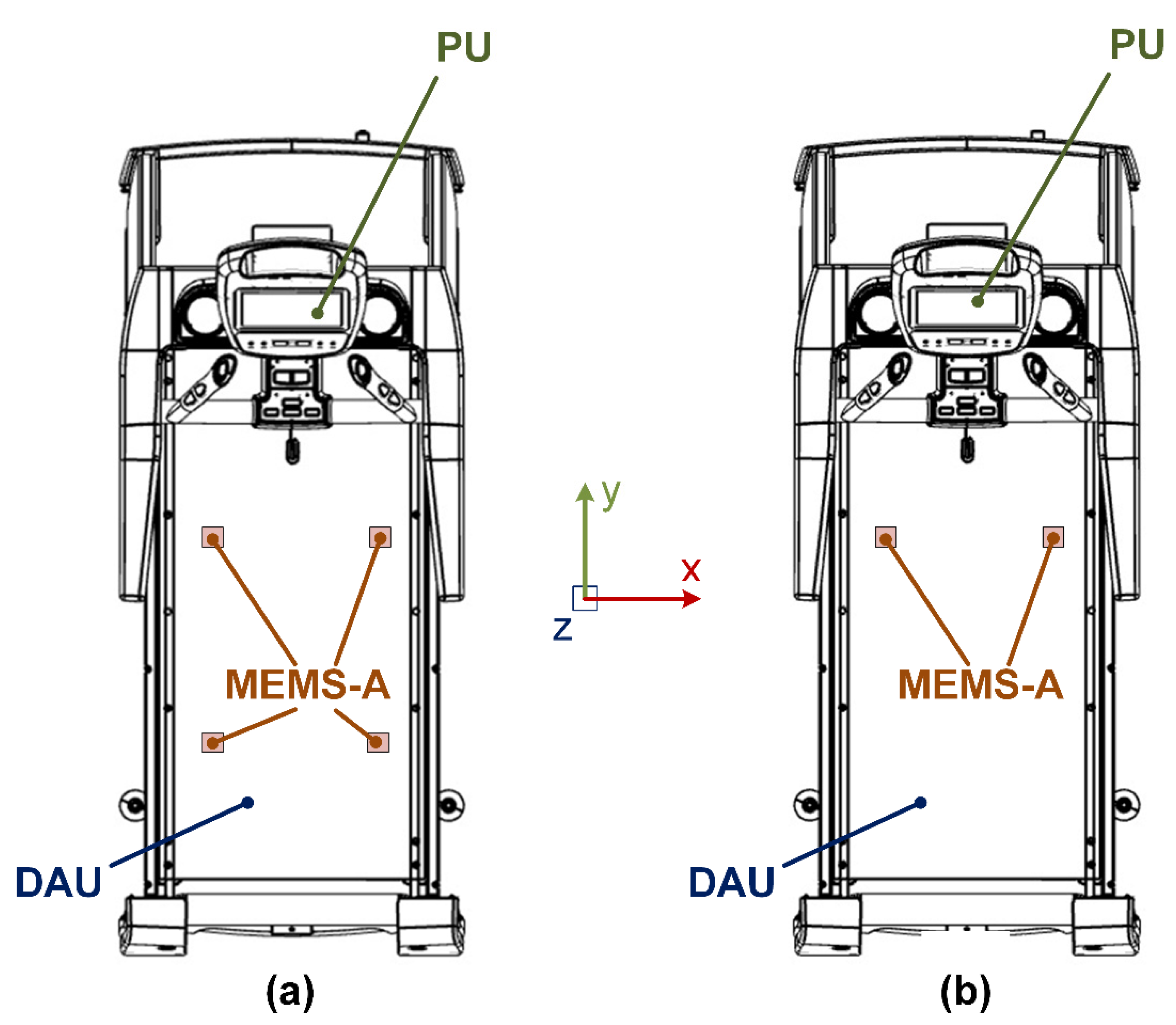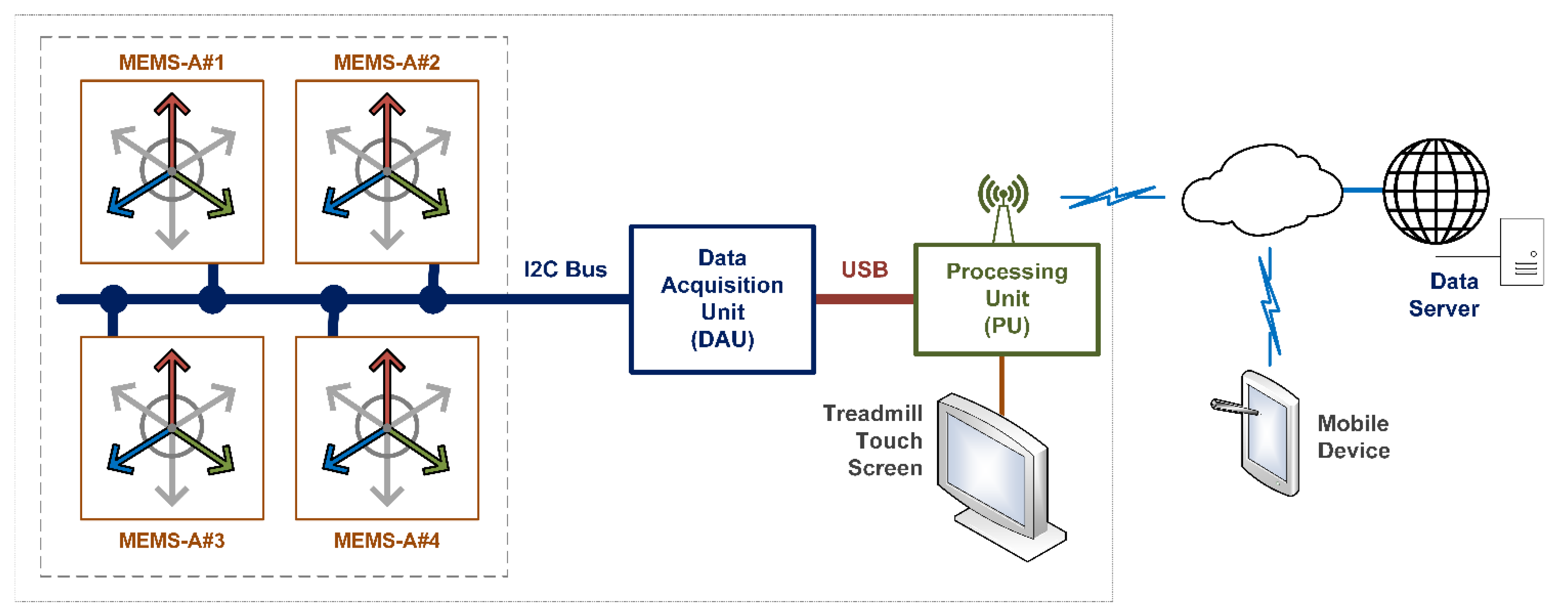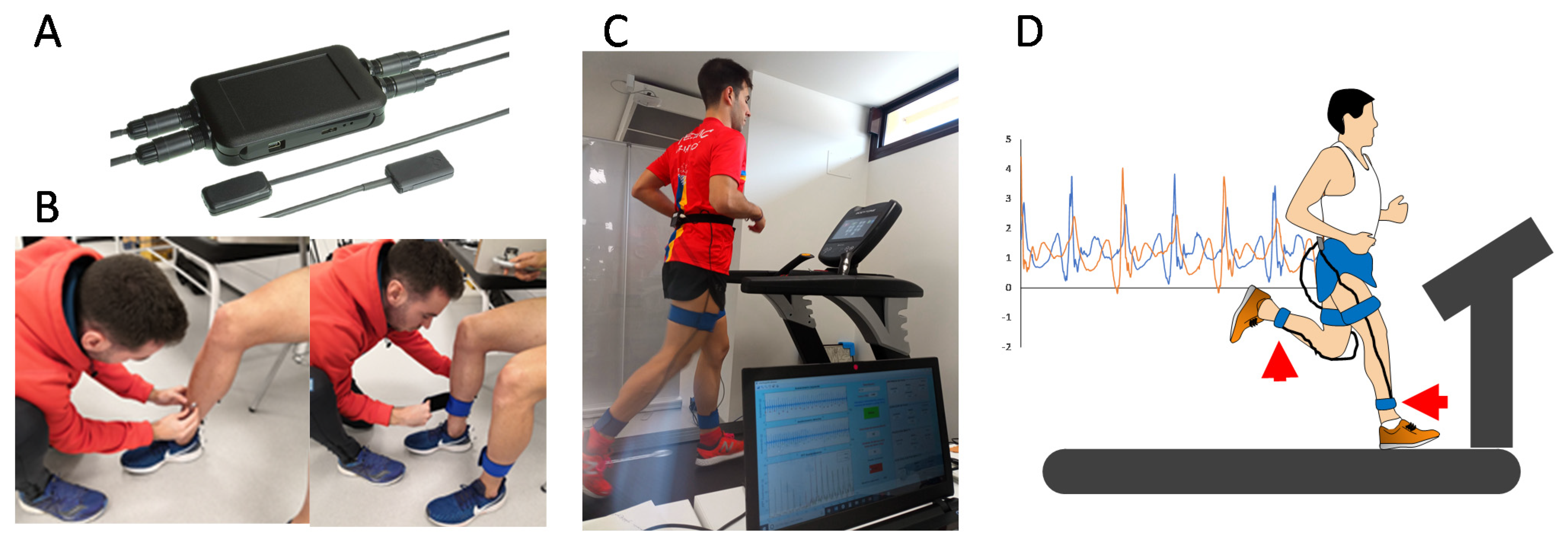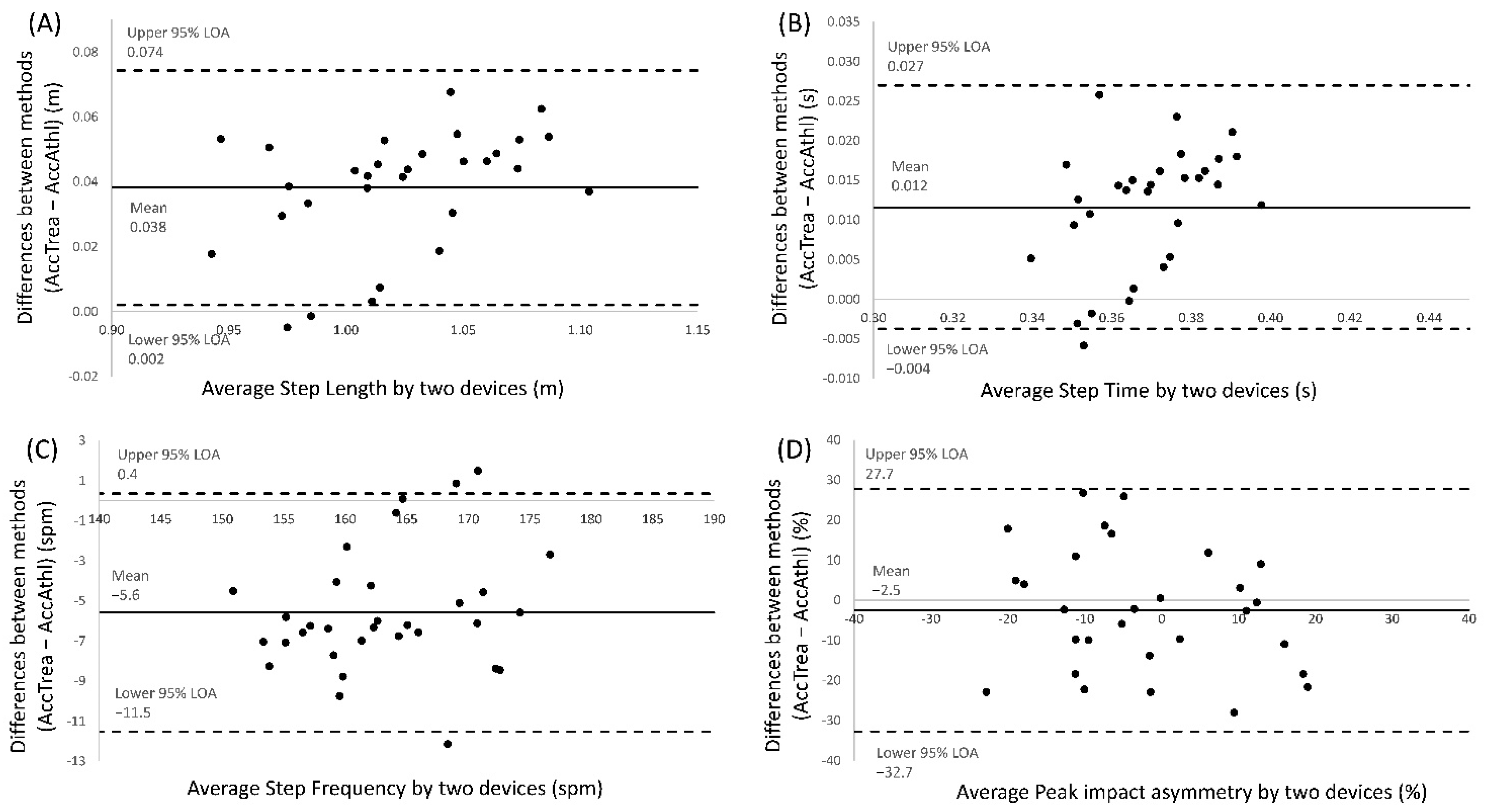Validity and Reliability of an Instrumented Treadmill with an Accelerometry System for Assessment of Spatio-Temporal Parameters and Impact Transmission
Abstract
1. Introduction
2. Materials and Methods
2.1. Participants
2.2. Experimental Setups
2.3. Statistics
3. Results
3.1. Gender Differences
3.2. Perceived Exertion
3.3. Bland–Altman Plots
3.4. Validity and Reliability
4. Discussion
5. Conclusions
6. Patents
Author Contributions
Funding
Institutional Review Board Statement
Informed Consent Statement
Acknowledgments
Conflicts of Interest
Appendix A. Treadmill Accelerometry System (AccTrea)


Appendix B. Procedure for Calculating Spatio-Temporal Parameters

References
- Fields, K.B.; Sykes, J.C.; Walker, K.M.; Jackson, J.C. Prevention of running injuries. Curr. Sports Med. Rep. 2010, 9, 176–182. [Google Scholar] [CrossRef] [PubMed]
- Van Gent, R.N.; Siem, D.; van Middelkoop, M.; van Os, A.G.; Bierma-Zeinstra, S.M.; Koes, B.W. Incidence and determinants of lower extremity running injuries in long distance runners: A systematic review. Br. J. Sports Med. 2007, 41, 469–480. [Google Scholar] [CrossRef] [PubMed]
- Cheung, R.T.; Wong, M.Y.; Ng, G.Y. Effects of motion control footwear on running: A systematic review. J. Sports Sci. 2011, 29, 1311–1319. [Google Scholar] [CrossRef] [PubMed]
- Hreljac, A.; Ferber, R. A biomechanical perspective of predicting injury risk in running: Review article. Int. J. Sports Med. 2006, 7, 98–108. [Google Scholar]
- Van der Worp, M.P.; ten Haaf, D.S.; van Cingel, R.; de Wijer, A.; Nijhuis-van der Sanden, M.W.; Staal, J.B. Injuries in runners; a systematic review on risk factors and sex differences. PLoS ONE 2015, 10, e0114937. [Google Scholar] [CrossRef]
- Mizrahi, J.; Verbitsky, O.; Isakov, E.; Daily, D. Effect of fatigue on leg kinematics and impact acceleration in long distance running. Hum. Mov. Sci. 2000, 19, 139–151. [Google Scholar] [CrossRef]
- Lucas-Cuevas, A.G.; Priego-Quesada, J.I.; Aparicio, I.; Giménez, J.V.; Llana-Belloch, S.; Pérez-Soriano, P. Effect of 3 Weeks Use of Compression Garments on Stride and Impact Shock during a Fatiguing Run. Int. J. Sports Med. 2015, 36, 826–831. [Google Scholar] [CrossRef]
- Derrick, T.R.; Dereu, D.; McLean, S.P. Impacts and kinematic adjustments during an exhaustive run. Med. Sci. Sports Exerc. 2002, 34, 998–1002. [Google Scholar] [CrossRef]
- Encarnación-Martínez, A.; García-Gallart, A.; Gallardo, A.M.; Sánchez-Sáez, J.A.; Sánchez-Sánchez, J. Effects of structural components of artificial turf on the transmission of impacts in football players. Sports Biomech. 2018, 17, 251–260. [Google Scholar] [CrossRef]
- Gruber, A.H.; Boyer, K.A.; Derrick, T.R.; Hamill, J. Impact shock frequency components and attenuation in rearfoot and forefoot running. J. Sport. Health Sci. 2014, 3, 113–121. [Google Scholar] [CrossRef]
- Mercer, J.A.; Bates, B.T.; Dufek, J.S.; Hreljac, A. Characteristics of shock attenuation during fatigued running. J. Sports Sci. 2003, 21, 911–919. [Google Scholar] [CrossRef]
- Hamill, J.; Derrick, T.R.; Holt, K.G. Shock attenuation and stride frequency during running. Hum. Mov. Sci. 1995, 14, 45–60. [Google Scholar] [CrossRef]
- García-Pérez, J.A.; Pérez-Soriano, P.; Llana Belloch, S.; Lucas-Cuevas, A.G.; Sánchez-Zuriaga, D. Effects of treadmill running and fatigue on impact acceleration in distance running. Sports Biomech. 2014, 13, 259–266. [Google Scholar] [CrossRef]
- Tessutti, V.; Trombini-Souza, F.; Ribeiro, A.P.; Nunes, A.L.; Sacco Ide, C. In-shoe plantar pressure distribution during running on natural grass and asphalt in recreational runners. J. Sci. Med. Sport 2010, 13, 151–155. [Google Scholar] [CrossRef] [PubMed]
- Miller, J.R.; Van Hooren, B.; Bishop, C.; Buckley, J.D.; Willy, R.W.; Fuller, J.T. A Systematic Review and Meta-Analysis of Crossover Studies Comparing Physiological, Perceptual and Performance Measures between Treadmill and Overground Running. Sports Med. 2019, 49, 763–782. [Google Scholar] [CrossRef] [PubMed]
- García-Pérez, J.A.; Pérez-Soriano, P.; Llana, S.; Martínez-Nova, A.; Sánchez-Zuriaga, D. Effect of overground vs treadmill running on plantar pressure: Influence of fatigue. Gait Posture 2013, 38, 929–933. [Google Scholar] [CrossRef] [PubMed]
- Wank, V.; Frick, U.; Schmidtbleicher, D. Kinematics and electromyography of lower limb muscles in overground and treadmill running. Int. J. Sports Med. 1998, 19, 455–461. [Google Scholar] [CrossRef] [PubMed]
- Milgrom, C.; Finestone, A.; Segev, S.; Olin, C.; Arndt, T.; Ekenman, I. Are overground or treadmill runners more likely to sustain tibial stress fracture? Br. J. Sports Med. 2003, 37, 160–163. [Google Scholar] [CrossRef]
- Mileti, I.; Serra, A.; Wolf, N.; Munoz-Martel, V.; Ekizos, A.; Palermo, E.; Arampatzis, A.; Santuz, A. Muscle Activation Patterns Are More Constrained and Regular in Treadmill than in Overground Human Locomotion. Front. Bioeng. Biotechnol. 2020, 8, 581619. [Google Scholar] [CrossRef]
- Eriksson, M.; Halvorsen, K.A.; Gullstrand, L. Immediate effect of visual and auditory feedback to control the running mechanics of well-trained athletes. J. Sports Sci. 2011, 29, 253–262. [Google Scholar] [CrossRef]
- Crowell, H.P.; Davis, I.S. Gait retraining to reduce lower extremity loading in runners. Clin. Biomech. 2011, 26, 78–83. [Google Scholar] [CrossRef]
- Wood, C.M.; Kipp, K. Use of audio biofeedback to reduce tibial impact accelerations during running. J. Biomech. 2014, 47, 1739–1741. [Google Scholar] [CrossRef] [PubMed]
- Clansey, A.C.; Hanlon, M.; Wallace, E.S.; Nevill, A.; Lake, M.J. Influence of tibial shock feedback training on impact loading and running economy. Med. Sci. Sports Exerc. 2014, 46, 973–981. [Google Scholar] [CrossRef]
- Nummela, A.T.; Paavolainen, L.M.; Sharwood, K.A.; Lambert, M.I.; Noakes, T.D.; Rusko, H.K. Neuromuscular factors determining 5 km running performance and running economy in well-trained athletes. Eur. J. Appl. Physiol. 2006, 97, 1–8. [Google Scholar] [CrossRef]
- Gullstrand, L.; Nilsson, J. A new method for recording the temporal pattern of stride during treadmill running. Sports Eng. 2009, 11, 195–200. [Google Scholar] [CrossRef]
- Möckel, G.; Perka, C.; Labs, K.; Duda, G. The influence of walking speed on kinetic and kinematic parameters in patients with osteoarthritis of the hip using a force-instrumented treadmill and standardised gait speeds. Arch. Orthop. Trauma Surg. 2003, 123, 278–282. [Google Scholar] [CrossRef]
- Donath, L.; Faude, O.; Lichtenstein, E.; Nüesch, C.; Mündermann, A. Validity and reliability of a portable gait analysis system for measuring spatiotemporal gait characteristics: Comparison to an instrumented treadmill. J. Neuroeng. Rehabil. 2016, 13, 6. [Google Scholar] [CrossRef]
- Watkins, C.M.; Maunder, E.; Tillaar, R.V.D.; Oranchuk, D.J. Concurrent Validity and Reliability of Three Ultra-Portable Vertical Jump Assessment Technologies. Sensors 2020, 20, 7240. [Google Scholar] [CrossRef]
- Encarnación-Martínez, A.; Berenguer-Vidal, R.; García-Gallart, A.; Rodríguez-Mayol, F.A.; Pernías-Reverte, J.J.; Pérez-Soriano, P. Ergometric Treadmill for Sport Training. US Patent US20200353309A1, 7 May 2019. [Google Scholar]
- Encarnación-Martínez, A.; Berenguer-Vidal, R.; García-Gallart, A.; Rodríguez-Mayol, F.A.; Pernías-Reverte, J.J.; Pérez-Soriano, P. Force Measuring Running Machine for Sports Training. CN Patent CN111905333A, 7 May 2019. [Google Scholar]
- Encarnación-Martínez, A.; Berenguer-Vidal, R.; García-Gallart, A.; Rodríguez-Mayol, F.A.; Pernías-Reverte, J.J.; Pérez-Soriano, P. Treadmill for Sport Training. EP Patent EP3735900A1, 7 May 2019. [Google Scholar]
- Ursel, T.; Olinski, M. Displacement Estimation Based on Optical and Inertial Sensor Fusion. Sensors 2021, 21, 1390. [Google Scholar] [CrossRef]
- Rybarczyk, D. Application of the MEMS Accelerometer as the Position Sensor in Linear Electrohydraulic Drive. Sensors 2021, 21, 1479. [Google Scholar] [CrossRef]
- Zhang, J.; Huang, W.; Zhang, W.; Li, F.; Du, Y. Train-Induced Vibration Monitoring of Track Slab under Long-Term Temperature Load Using Fiber-Optic Accelerometers. Sensors 2021, 21, 787. [Google Scholar] [CrossRef] [PubMed]
- Kim, K.; Sohn, H. Dynamic Displacement Estimation for Long-Span Bridges Using Acceleration and Heuristically Enhanced Displacement Measurements of Real-Time Kinematic Global Navigation System. Sensors 2020, 20, 5092. [Google Scholar] [CrossRef] [PubMed]
- Won, J.; Park, J.; Park, J.W.; Kim, I. BLESeis: Low-Cost IoT Sensor for Smart Earthquake Detection and Notification. Sensors 2020, 20, 2963. [Google Scholar] [CrossRef]
- Arranz-Martínez, F.; Martín-Ferrer, R.; Palacios-Navarro, G.; Ramos-Lorente, P. Study on the Vibration Characteristics of the Telescope T80 in the Javalambre Astrophysical Observatory (JAO) Aimed at Detecting Invalid Images. Sensors 2020, 20, 6523. [Google Scholar] [CrossRef] [PubMed]
- Lucas-Cuevas, A.G.; Encarnación-Martínez, A.; Camacho-García, A.; Llana-Belloch, S.; Pérez-Soriano, P. The location of the tibial accelerometer does influence impact acceleration parameters during running. J. Sports Sci. 2017, 35, 1734–1738. [Google Scholar] [CrossRef] [PubMed]
- Lavcanska, V.; Taylor, N.F.; Schache, A.G. Familiarization to treadmill running in young unimpaired adults. Hum. Mov. Sci. 2005, 24, 544–557. [Google Scholar] [CrossRef]
- Lucas-Cuevas, A.G.; Pérez-Soriano, P.; Llana-Belloch, S.; Macián-Romero, C.; Sánchez-Zuriaga, D. Effect of custom-made and prefabricated insoles on plantar loading parameters during running with and without fatigue. J. Sports Sci. 2014, 32, 1712–1721. [Google Scholar] [CrossRef]
- Borg, G.A. Psychophysical bases of perceived exertion. Med. Sci. Sports Exerc. 1982, 14, 377–381. [Google Scholar] [CrossRef]
- Van den Berghe, P.; Six, J.; Gerlo, J.; Leman, M.; De Clercq, D. Validity and reliability of peak tibial accelerations as real-time measure of impact loading during over-ground rearfoot running at different speeds. J. Biomech. 2019, 86, 238–242. [Google Scholar] [CrossRef]
- Oppenheim, A. Discrete-Time Signal. Processing: Pearson New International Edition; Pearson: London, UK, 2013. [Google Scholar]
- Batista, P.; Silvestre, C.; Oliveira, P.; Cardeira, B. Accelerometer Calibration and Dynamic Bias and Gravity Estimation: Analysis, Design, and Experimental Evaluation. IEEE Trans. Control. Syst. Technol. 2011, 19, 1128–1137. [Google Scholar] [CrossRef]
- Bland, J.M.; Altman, D.G. Statistical methods for assessing agreement between two methods of clinical measurement. Lancet 1986, 1, 307–310. [Google Scholar] [CrossRef]
- Shrout, P.E.; Fleiss, J.L. Intraclass correlations: Uses in assessing rater reliability. Psychol. Bull. 1979, 86, 420–428. [Google Scholar] [CrossRef]
- Fleiss, J.L. The Design and Analysis of Clinical Experiments; John Wiley & Sons: New York, NY, USA, 1986. [Google Scholar]
- Jacobson, N.S.; Truax, P. Clinical significance: A statistical approach to defining meaningful change in psychotherapy research. J. Consult. Clin. Psychol. 1991, 59, 12–19. [Google Scholar] [CrossRef] [PubMed]
- Hong, Y.; Wang, L.; Li, J.X.; Zhou, J.H. Comparison of plantar loads during treadmill and overground running. J. Sci. Med. Sport 2012, 15, 554–560. [Google Scholar] [CrossRef] [PubMed]
- Ogueta-Alday, A.; Morante, J.C.; Rodríguez-Marroyo, J.A.; García-López, J. Validation of a new method to measure contact and flight times during treadmill running. J. Strength Cond. Res. 2013, 27, 1455–1462. [Google Scholar] [CrossRef]
- Hanley, B.; Tucker, C.B. Gait variability and symmetry remain consistent during high-intensity 10,000 m treadmill running. J. Biomech. 2018, 79, 129–134. [Google Scholar] [CrossRef] [PubMed]
- Horvais, N.; Samozino, P.; Chiementin, X.; Morin, J.B.; Giandolini, M. Cushioning perception is associated with both tibia acceleration peak and vibration magnitude in heel-toe running. Footwear Sci. 2019, 11, 35–44. [Google Scholar] [CrossRef]
- Garofolini, A.; Taylor, S.; Lepine, J. Evaluating dynamic error of a treadmill and the effect on measured kinetic gait parameters: Implications and possible solutions. J. Biomech. 2019, 82, 156–163. [Google Scholar] [CrossRef] [PubMed]
- Letafatkar, A.; Rabiei, P.; Farivar, N.; Alamouti, G. Long-term efficacy of conditioning training program combined with feedback on kinetics and kinematics in male runners. Scand. J. Med. Sci. Sports 2020, 30, 429–441. [Google Scholar] [CrossRef]
- Leens, F. An introduction to I 2 C and SPI protocols. IEEE Instrum. Meas. Mag. 2009, 12, 8–13. [Google Scholar] [CrossRef]
- Pérez-Soriano, P.; Encarnación-Martínez, A. Análisis de impactos mediante técnicas de acelerometría. In Metodología y Aplicación Práctica de la biomecánica Deportiva; Pérez-Soriano, P., Ed.; Paidotribo: Badalona, Spain, 2018; pp. 9–20. [Google Scholar]


| Characteristics (M ± SD) | Female (n = 10) | Male (n = 20) |
|---|---|---|
| Age, y | 24.4 ± 6.1 | 27.2 ± 7.5 |
| Weight, kg | 55.8 ± 4.0 | 73.3 ± 8.0 |
| Height, cm | 161.3 ± 4.3 | 175.6 ± 5.1 |
| BMI, kg/m2 | 21.4 ± 1.3 | 23.7 ± 2.3 |
| Day 1 | Day 2 | p Value 1 | |
|---|---|---|---|
| Warm-up (M ± SD) | 9.0 ± 1.9 | 8.8 ± 2.0 | 0.68 |
| Running test (M ± SD) | 9.8 ± 1.6 | 9.5 ± 1.8 | 0.46 |
| AccTrea | AccAthl | Mean Diff (95%CI) | ICC (95%CI) | |
|---|---|---|---|---|
| Step Length (m) | ||||
| Day 1 (M ± SD) | 1.04 ± 0.05 | 1.01 ± 0.04 | 0.04 (0.03/0.05) | 0.94 (0.87/0.97) |
| Day 2 (M ± SD) | 1.03 ± 0.04 | 1.00 ± 0.05 | 0.04 (0.03/0.05) | 0.95 (0.89/0.98) |
| Mean Diff (95%CI) | 0.002 (−0.005/0.010) | 0.011 (−0.002/0.023) | ||
| ICC (95%CI) | 0.92 (0.82/0.96) | 0.88 (0.73/0.95) | ||
| SEM (% SEM) | 0.01 (1.31) | 0.01 (1.29) | ||
| MDC (%) | 0.04 | 0.04 | ||
| Step Time (ms) | ||||
| Day 1 (M ± SD) | 374.8 ± 16.8 | 363.1 ± 13.9 | 12.5 (9.7/15.3) | 0.94 (0.87/0.97) |
| Day 2 (M ± SD) | 371.8 ± 15.2 | 359.7 ± 17.1 | 13.0 (10.1/15.9) | 0.95 (0.89/0.98) |
| Mean Diff (95%CI) | 0.88 (−1.75/3.51) | 3.85 (−0.60/8.29) | ||
| ICC (95%CI) | 0.96 (0.90/0.98) | 0.89 (0.73/0.95) | ||
| SEM (% SEM) | 3.55 (0.95) | 4.7 (1.29) | ||
| MDC (%) | 9.85 | 13.03 | ||
| Step Frequency (spm) | ||||
| Day 1 (M ± SD) | 160.5 ± 7.2 | 166.1 ± 6.6 | −5.59 (−6.7/−4.5) | 0.95 (0.90/0.97) |
| Day 2 (M ± SD) | 161.3 ± 6.7 | 167.1 ± 8.0 | −5.94 (−7.2/−4.7) | 0.95 (0.89/0.98) |
| Mean Diff (95%CI) | −0.17 (−1.24/0.89) | −0.80 (−2.9/1.3) | ||
| ICC (95%CI) | 0.96 (0.91/0.98) | 0.91 (0.82/0.93) | ||
| SEM (% SEM) | 1.48 (0.92) | 1.97 (1.19) | ||
| MDC (%) | 4.12 | 5.47 | ||
| Left Leg Peak Impact (g) | ||||
| Day 1 (M ± SD) | 0.72 ± 0.21 | 3.76 ± 1.37 | −3.04 (−3.53/−2.56) | 0.09 (−0.86/0.56) |
| Day 2 (M ± SD) | 0.72 ± 0.22 | 3.93 ± 1.30 | −3.21 (−3.69/−2.73) | 0.08 (−0.93/0.56) |
| Mean Diff (95%CI) | 0.001 (−0.052/0.053) | −0.181 (−0.514/0.152) | ||
| ICC (95%CI) | 0.88 (0.75/0.94) | 0.88 (0.74/0.94) | ||
| SEM (% SEM) | 0.07 (10.05) | 0.48 (12.25) | ||
| MDC (%) | 0.20 | 1.34 | ||
| Right Leg Peak Impact (g) | ||||
| Day 1 (M ± SD) | 0.73 ± 0.20 | 3.91 ± 1.62 | −3.18 (−3.76/−2.59) | 0.01 (−1.04/0.52) |
| Day 2 (M ± SD) | 0.76 ± 0.18 | 3.97 ± 1.71 | −3.21 (−3.85/−2.56) | −0.01 (−1.13/0.52) |
| Mean Diff (95%CI) | −0.03 (−0.08/0.02) | −0.05 (−0.42/0.32) | ||
| ICC (95%CI) | 0.85 (0.69/0.93) | 0.90 (0.80/0.95) | ||
| SEM (% SEM) | 0.08 (10.20) | 0.50 (12.64) | ||
| MDC (%) | 0.21 | 1.39 | ||
| Peak Impact Asymmetry (%) | ||||
| Day 1 (M ± SD) | −2.80 ± 12.53 | −1.29 ± 14.49 | −1.51(15.11/2.67) | 0.55 (0.07/0.78) |
| Day 2 (M ± SD) | −2.75 ± 9.79 | 2.44 ± 17.94 | −6.16 (18.34/3.47) | 0.28 (−0.55/0.67) |
| Mean Diff (95%CI) | 0.75 (14.16/2.63) | −3.82 (14.94/2.77) | ||
| ICC (95%CI) | 0.36 (−0.37/0.70) | 0.75 (0.46/0.88) | ||
| SEM (% SEM) | 10.04 (−358.66) | 7.28 (297.729) | ||
| MDC (%) | 27.82 | 20.17 | ||
Publisher’s Note: MDPI stays neutral with regard to jurisdictional claims in published maps and institutional affiliations. |
© 2021 by the authors. Licensee MDPI, Basel, Switzerland. This article is an open access article distributed under the terms and conditions of the Creative Commons Attribution (CC BY) license (http://creativecommons.org/licenses/by/4.0/).
Share and Cite
Encarnación-Martínez, A.; Pérez-Soriano, P.; Sanchis-Sanchis, R.; García-Gallart, A.; Berenguer-Vidal, R. Validity and Reliability of an Instrumented Treadmill with an Accelerometry System for Assessment of Spatio-Temporal Parameters and Impact Transmission. Sensors 2021, 21, 1758. https://doi.org/10.3390/s21051758
Encarnación-Martínez A, Pérez-Soriano P, Sanchis-Sanchis R, García-Gallart A, Berenguer-Vidal R. Validity and Reliability of an Instrumented Treadmill with an Accelerometry System for Assessment of Spatio-Temporal Parameters and Impact Transmission. Sensors. 2021; 21(5):1758. https://doi.org/10.3390/s21051758
Chicago/Turabian StyleEncarnación-Martínez, Alberto, Pedro Pérez-Soriano, Roberto Sanchis-Sanchis, Antonio García-Gallart, and Rafael Berenguer-Vidal. 2021. "Validity and Reliability of an Instrumented Treadmill with an Accelerometry System for Assessment of Spatio-Temporal Parameters and Impact Transmission" Sensors 21, no. 5: 1758. https://doi.org/10.3390/s21051758
APA StyleEncarnación-Martínez, A., Pérez-Soriano, P., Sanchis-Sanchis, R., García-Gallart, A., & Berenguer-Vidal, R. (2021). Validity and Reliability of an Instrumented Treadmill with an Accelerometry System for Assessment of Spatio-Temporal Parameters and Impact Transmission. Sensors, 21(5), 1758. https://doi.org/10.3390/s21051758








